Looking for feed to fatten snails
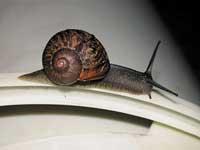
In the cultivation of snails, as in any other type of artificial culture, it is necessary to take into account the density of population, the temperature, the luminosity, the cleaning of the environment and the snails, the appropriate humidity conditions and, how not, the feeding.
A team of researchers from the University of the Basque Country works to improve the feeding of the shells of nurseries. In fact, while they remain in the nurseries, before passing to natural areas of fattening populated by radishes, clovers and other herbs and vegetables, the snails eat a food prepared for them.
The quality of the feed has much to do with the growth of the snails. The more I think better, the more balanced the food is, the better and healthier the snails grow. Being a food that is sold by weight, it is evident the influence that can have the delivery of a suitable feed on the profitability of nurseries.
Analyzing growth

One of these investigations to improve feed is being carried out at the Faculty of Sciences of Leioa, under the direction of Professor Mercedes Ortega. First, researchers want to know what and how much each snail eats. For this purpose, the snails receive an individual treatment in the laboratories of Leioa. When they arrive at the laboratory, each snail is placed a number in the shell to then be able to know with ease all the incidences.
They catch snails one by one and weigh them and measure them first. In this way, when they arrive at the laboratory, they know of their size.
Once the initial data is collected, the snails put them in glass boxes and put them water and food. For a few days they will remain in the boxes, mainly at rest and for the rest of the time eating the food prepared for them. They control at all times and take and weigh them several times. In addition, they keep them in the best possible conditions of humidity and temperature for them, so they can be quiet without incident.

To know how much oxygen the snails absorb, gauges are used. With the snail inside, the gauges must be submerged. Pieces of lead are placed on the sides to prevent the containers from coming into the water.
Feces, composition and weight are also studied, analyzing each of the snails. They take the snails, remove them from the boxes and weigh the manure and the remaining food. In this way, they discover how much the snail has eaten and how much it has devastated and, therefore, how much it has taken advantage of what it has eaten.
On the other hand, UPV researchers use more complex techniques. The aim of these tests is to measure growth, but they want to know not only the global growth of the snail, but also that of each section.
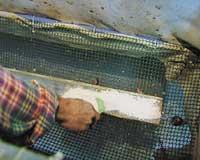
To do this, the animals are dissected to know which part of the body is going energy. Subsequently, we proceed to take these samples and their lyophilization, that is, to freeze the samples and to remove the water from them, to dry them. The sample is usually frozen, so the biochemical substances present inside are not altered: proteins, lipids, carbohydrates, etc. When the sample is freeze-dried, biochemical analyses are performed by a homogenization, homogenization, spraying. Subsequently, this homogeneous powder is stored and analyzed when necessary.
After analyzing the data extracted from all these tests, the researchers of the UPV/EHU want to develop the best thought for the growth of the snails. In fact, it seems that the growth of the snails, the heliciculture, is an economic activity that is expanding more and more.
Heliciculture in the Basque Country
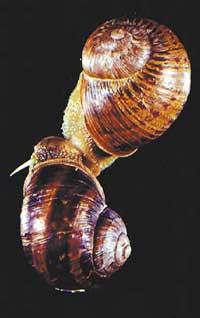
As an economic activity, UPV researchers do not work alone. They collaborate with a shell nursery located in Lezo. The nursery belongs to the Jokin Urdangarin and sells its snails under the name of Jep Euskadi. The snails analyzed in the laboratories of Leioa belong to the species Helix aspersa Müller, which leaves this nursery.
The shell nursery of Lezo is prepared for reproduction, has as objective the copulation. So the snails are very well cared for. They are at the right temperature at all times, between 14 and 24 degrees and with a humidity greater than 60%, since the snails please warm and humid zones. In addition, they are well fed and clean. Although there is room for more, there are only 20 cages in this place. In each cage about 500 snails, with which about 10,000 snails in total. More cages would be placed in the nursery, but then fattening areas are needed, so they cannot be given out.
The snails eat a lot of feed. At the base of this feed are corn, soybeans, wheat, calcium and vitamins, as well as other ingredients. It is the same thing they have used for years in Catalonia, not what the UPV researchers are forming. As they eat a lot of feed, snails also make a lot of shit. Therefore, cages should be cleaned well to avoid diseases.
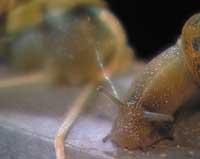
They use water for it. The cages are of wire, so they have an automatic irrigation system so that when necessary the water is poured and the excrements fall to the ground.
Towards reproduction
The most important task of cultivation is copulation. After a dance that can last twelve hours, the snails are tied. One makes of male and the other of female, hermaphrodites. The male leaves the neck a species of horn and puts it on the neck of the female. In fact, snails are nocturnal and use the night for copulation, among other things, but when wet with water, wake up and join during the day. The copulation lasts about 24 hours. When it ends, the snails are separated, but not completely. They have a thin transparent thread that still connects with each other, a sign that the copulation has finished.
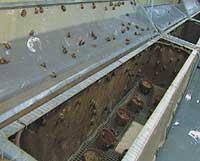
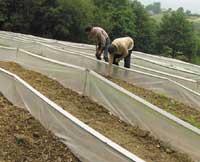
Between 5 and 6 hours after copulation, the female snail has to find a place where to lay the eggs. It lays its eggs buried about 200 per dome. The laying is carried out exclusively in the containers enabled for this purpose. They are observed in the vases of the cages and, supposedly, are extracted. If it is slowly pulled from the snail and released immediately it is a sign that all the eggs have been laid, while if it is well glued to the ground it still stretches. The eggs stay a few days in these pots, but then you have to change them to others. After about 21 days the baby snail is born.
The eggs are carried to bait, that is, to the meadows prepared to fattening the snails. The fattening area of the nursery of Lezo is located in a hamlet of Errenteria. When they leave the eggs, in specially prepared areas, the snails find radishes and clover everywhere. They have been getting fat for a few months. Then they pick them up and send them to Catalonia. There they are cleaned, cooked and frozen and then deposited in bags and brought to human consumption. This year about a million snails have left the fattening area of Errenteria.
The snails, of nursery, which have not been sent to the bait, are dormen towards October. Put them in sacks and take them to Barcelona so that in their special chambers they spend the winter sleep of 5-6 degrees. Next spring they will bring back most of the strongest. It is, therefore, of genetically improved snails, since from generation to generation the healthiest and strongest snails are chosen.

The snail, curiosity
- It is not clear whether or not he has vision, since even touching with tentacles does not react with the obstacles he finds in the way. With strong lights he sees nothing and seems to be able to detect shapes in the dark. If it is mute and can be deaf. However, it differentiates air movements or temperature changes. It has very developed taste, touch and smell.
- It is hermaphrodite, but not absolute, since it needs another snail to reproduce.
- Light has a great importance in the life of the snail because it seeks the darkness to sleep. It moves at night or in days of little light, never with sun, even if the soil is wet.
- It accompanies the humidity and the rain, then takes advantage to eat, move and reproduce; the drought gives it sleep.
- The snail is inserted into the nozzle if it is in an environment poor in oxygen, which reduces the amount of oxygen needed.
- The shell distinguishes the shell from the body. The shell protects the shell. Protects from shocks, heat, light, cold, etc. In the body, the head, visceral mass and the foot are distinguished. In the head there are two tentacles with eyes and under two other for touch. Lower your mouth. Behind, at the top of the foot, appears the sexual organ. The foot is about half of the body and is the cradle of the mucus that helps you move. Inside the shell presents a visceral mass with apparatus of digestion, breathing, excretion, circulation and reproduction.
- In the eating habits of some species of mice, rats, lirones, foxes, blackheads, ravens, snakes, lizards and frogs there are also snails, even of some insects or coleoptera.





